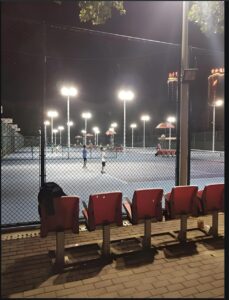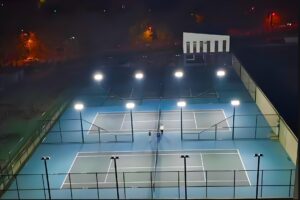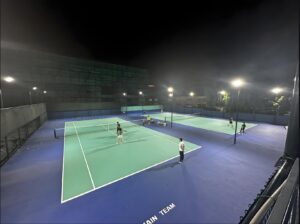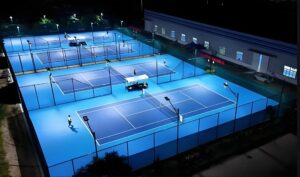- Energy Efficiency and Sustainability: Controlling light spill is essential for energy efficiency. By focusing the light precisely where it is needed, LEDs reduce the amount of energy lost to spill, which in turn reduces operational costs. This is particularly important in large venues where multiple light sources are used. The efficient use of light not only helps in cutting energy consumption but also aligns with sustainability efforts by minimizing unnecessary environmental impact.
- Maintaining Focus on the Playing Area: For players and viewers alike, it’s crucial that the lighting is focused on the playing surface without being wasted on adjacent areas. Light spill can draw attention away from the game, diminishing the overall experience. When light spill is minimized, the playing surface becomes the focal point, ensuring that all eyes are on the action and creating an immersive atmosphere for both athletes and spectators.
4. Designing Effective Lighting to Control Glare and Spill
- Precise Light Placement: Modern LED lighting systems allow for precise placement of light sources, enabling a well-designed layout that directs light where it is needed most. By utilizing specialized reflectors, lenses, and diffusers, LEDs can focus the light precisely on the playing surface, ensuring uniform coverage while minimizing spill. This controlled placement of light ensures that areas outside the court are not over-illuminated, maintaining an optimal level of contrast for viewers and players.
- Advanced Optics for Glare Control: Advanced optics, such as specially designed lenses and reflectors, play a critical role in controlling glare. By carefully designing the light beam and directing it away from unwanted areas, these optical elements reduce glare and ensure that light is delivered to the exact spots needed for proper visibility. In tennis, for example, lights can be positioned in a way that avoids casting shadows or creating reflections on the court, enhancing the player’s experience.
- Adjustable Beam Angles: LEDs allow for easy adjustment of beam angles, which helps to refine light direction and spread. This adjustability is crucial for controlling glare and spill in dynamic environments like sports venues. By tailoring the beam angles of the lights, lighting designers can direct the light only where it’s needed, reducing spill into surrounding areas and minimizing glare for both players and viewers.
 5. Benefits of Glare and Spill Control in Tennis
5. Benefits of Glare and Spill Control in Tennis
- Improved Player Experience: For tennis players, consistent and glare-free lighting ensures that their attention is solely on the ball and the game. This level of focus is critical for high-level performance, where split-second decisions and accurate ball tracking are vital. With glare reduced and light spill minimized, players can perform at their best without visual distractions.
- Enhanced Broadcast Quality: In tennis, where clarity and visual precision are paramount for viewers, minimizing glare and controlling spill are essential for high-definition broadcasts. The absence of distracting lighting artifacts ensures that the audience at home enjoys a crisp, clear image of the action, even during slow-motion replays or high-speed movements.
- Spectator Comfort and Enjoyment: Glare and spill control contribute to a more enjoyable experience for spectators, both in person and at home. Whether in a stadium or watching on television, comfortable viewing conditions ensure that fans can follow the action without distractions, improving their overall enjoyment of the event.
Controlling glare and light spill is an essential aspect of sports lighting that contributes to both player and viewer comfort. For players, minimizing glare ensures clear, distraction-free vision, which is crucial for performance, focus, and comfort. For viewers, controlling glare improves the visual quality of broadcasts and creates a more immersive experience. Additionally, controlling spill light reduces energy waste, enhances sustainability, and ensures that lighting is focused exactly where it’s needed. By employing advanced LED technology and precise optical systems, sports venues can provide optimal lighting conditions that enhance the quality of the game for all involved.
Color Temperature Control
The importance of color accuracy in tennis for ball visibility
In tennis, where quick reflexes, precise judgment, and concentration are essential for success, one of the most crucial factors influencing player performance is the ability to clearly see and track the ball. The color and visibility of the tennis ball directly impact a player’s ability to make split-second decisions, react swiftly, and maintain focus throughout a match. Proper lighting, especially in terms of color accuracy, plays an integral role in ensuring the ball is clearly visible under various lighting conditions, whether indoors, during the day, or at night. In this section, we explore the importance of color accuracy in tennis for ball visibility and how LED sports lighting meets the rigorous demands of the game.
1. Role of Color Accuracy in Ball Visibility
- Enhancing Contrast: Tennis balls are typically bright yellow or neon green, designed to stand out against the backdrop of the court, which can vary in color from grass to clay to hard surfaces. However, the true effectiveness of this contrast relies on the accuracy and quality of the lighting used. If the light source doesn’t have a correct color rendering capability, the ball can appear washed out or blend into the court, making it difficult for players to track. Accurate lighting ensures that the ball maintains its vivid, high-contrast color, helping players differentiate it from the court and surrounding environment.
- Fast-Moving Ball Visibility: Tennis involves a high-speed ball, often traveling at speeds exceeding 100 miles per hour. Under proper lighting, the ball’s bright color allows players to spot its trajectory and react appropriately. Lighting that inaccurately renders colors, distorting the ball’s appearance, can lead to slower reactions and a higher likelihood of missed shots. The importance of color accuracy is clear in this context: it enhances the visibility of the ball, giving players the clarity they need to respond effectively and improve their chances of success.
- Avoiding Color Distortion: When the color temperature of lighting is incorrect, it can distort the appearance of the tennis ball. For instance, overly warm (yellowish) lighting or cool (blueish) lighting can make the ball appear differently to the human eye, reducing the clarity with which it can be seen. Correct color accuracy ensures that the ball remains its true color, keeping it bright and visible, even under varied lighting conditions or at night when artificial lighting is necessary.
2. Color Rendering Index (CRI) and Its Impact on Ball Visibility
- What is CRI?: The Color Rendering Index (CRI) is a metric that measures the ability of a light source to reveal the true colors of objects compared to natural sunlight. A high CRI value indicates that the light source provides accurate color representation, whereas a low CRI means the light distorts or misrepresents colors. For sports lighting, especially in tennis, a high CRI is critical to ensuring the ball’s visibility.
- Importance of High CRI in Tennis Lighting: LEDs with a high CRI (typically above 90) ensure that the color of the tennis ball remains vibrant and true to its actual hue. This makes it easier for players to track the ball’s movement, anticipate its speed, and adjust their position accordingly. A lower CRI could cause the ball to look dull or off-color, making it harder for players to judge its speed and trajectory accurately, leading to mistakes or missed opportunities.
 3. Color Temperature and Its Effect on Tennis Ball Visibility
3. Color Temperature and Its Effect on Tennis Ball Visibility
- Optimal Color Temperature for Tennis Lighting: The color temperature of the lighting, measured in Kelvin (K), also influences ball visibility. Tennis balls are typically bright yellow or neon green, which require a cooler, whiter light to stand out clearly. Lighting with a color temperature in the range of 4000K to 5000K is ideal for outdoor and indoor tennis courts because it mimics natural daylight, providing excellent contrast and visibility for the ball without causing glare.
- Impact of Inaccurate Color Temperature: If the lighting has a color temperature that is too warm (below 3000K), the lighting may cast a yellowish hue, which can make the ball blend into the court or surrounding areas. On the other hand, lighting with a color temperature that is too cool (above 6000K) might make the ball appear washed out or too bright, reducing its clarity. Correct color temperature ensures that the ball’s color remains vibrant and clearly distinguishable against the court, enhancing player performance and reducing visual strain.
4. LED Advantages for Color Accuracy in Tennis
- Stable Color Performance: One of the key benefits of LED lighting is its stability over time. Unlike traditional lighting sources, which may shift in color over their lifespan, LEDs maintain consistent color output throughout their use. This ensures that the tennis ball will consistently appear the same color for players and viewers from the beginning to the end of a match, eliminating the need for frequent adjustments or replacements that can alter color accuracy.
- Customization Options: LED lights can be fine-tuned to match the specific color rendering needs of a tennis court. By adjusting the CRI, color temperature, and brightness, LED systems can be calibrated to provide optimal lighting conditions for ball visibility. Whether for outdoor or indoor tennis courts, LEDs can be customized to ensure that the ball is brightly visible, enabling players to track it efficiently and minimizing any issues caused by poor color rendering.
5. Impact on Player Performance
- Quick Decision Making: In tennis, players must make decisions in a fraction of a second—often based on their ability to judge the ball’s speed, spin, and trajectory. Proper color rendering allows players to more accurately gauge these factors. The quicker and more accurately players can assess the ball’s movement, the better their chances of positioning themselves correctly and returning shots effectively.
- Minimizing Eye Strain: Inadequate lighting, especially if the colors are distorted or inconsistent, can lead to eye strain, making it difficult for players to keep their eyes on the ball during fast exchanges. A high CRI and correct color temperature minimize visual fatigue by ensuring that the ball’s color is easy to distinguish from the background, enabling smoother and more focused gameplay.

6. Impact on Broadcast Quality and Viewer Experience
- Television and Online Broadcasts: Accurate color representation is also crucial for broadcasting tennis matches. When the ball’s color is distorted by improper lighting, it can negatively affect the viewing experience for audiences watching the match from home. A high CRI and correct color temperature ensure that the ball appears vibrant and clear on television screens, allowing viewers to follow the action without missing a beat.
- Enhanced Viewer Comfort: Just as players benefit from clear ball visibility, viewers also need to see the ball clearly. Whether the match is being broadcasted in HD or 4K, accurate color rendering enhances the viewer’s experience, making the game more enjoyable to watch. By maintaining the true color of the ball under different lighting conditions, LED systems create a better visual experience both for live audiences and those watching remotely.
In tennis, the ability to clearly see and track the ball is a fundamental aspect of performance. Proper color accuracy
in lighting ensures that the ball is visible, vibrant, and easy to track under any lighting condition. LED sports lighting offers significant advantages in this regard, providing high CRI, adjustable color temperature, and stable performance throughout the lifespan of the lights. By ensuring optimal color rendering, LED lighting helps players make faster, more accurate decisions, reduces eye strain, and enhances the overall viewing experience. Whether for players on the court or for fans watching at home, color accuracy is essential for both performance and enjoyment.
Adjustable color temperatures in LED systems and how they enhance player and viewer experience
Color temperature, measured in Kelvin (K), refers to the hue of light emitted by a lighting source. In sports venues, particularly tennis, lighting plays a crucial role in maintaining visibility, reducing glare, and enhancing the overall experience for both players and spectators. One of the significant advantages of modern LED lighting systems is their ability to offer adjustable color temperatures, allowing them to adapt to different environments and times of day. This flexibility enhances both player performance and viewer enjoyment by ensuring that the court is lit under optimal conditions. In this section, we explore the benefits of adjustable color temperatures in LED systems and how they contribute to an improved experience for both players and viewers in tennis matches.
(To Be Continued)
 5. Benefits of Glare and Spill Control in Tennis
5. Benefits of Glare and Spill Control in Tennis
 3. Color Temperature and Its Effect on Tennis Ball Visibility
3. Color Temperature and Its Effect on Tennis Ball Visibility